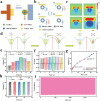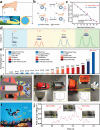Stretchable and Self-Powered Mechanoluminescent Triboelectric Nanogenerator Fibers toward Wearable Amphibious Electro-Optical Sensor Textiles
- PMID: 38970168
- PMCID: PMC11425994
- DOI: 10.1002/advs.202401109
Stretchable and Self-Powered Mechanoluminescent Triboelectric Nanogenerator Fibers toward Wearable Amphibious Electro-Optical Sensor Textiles
Abstract
Flexible electro-optical dual-mode sensor fibers with capability of the perceiving and converting mechanical stimuli into digital-visual signals show good prospects in smart human-machine interaction interfaces. However, heavy mass, low stretchability, and lack of non-contact sensing function seriously impede their practical application in wearable electronics. To address these challenges, a stretchable and self-powered mechanoluminescent triboelectric nanogenerator fiber (MLTENGF) based on lightweight carbon nanotube fiber is successfully constructed. Taking advantage of their mechanoluminescent-triboelectric synergistic effect, the well-designed MLTENGF delivers an excellent enhancement electrical signal of 200% and an evident optical signal whether on land or underwater. More encouragingly, the MLTENGF device possesses outstanding stability with almost unchanged sensitivity after stretching for 200%. Furthermore, an extraordinary non-contact sensing capability with a detection distance of up to 35 cm is achieved for the MLTENGF. As application demonstrations, MLTENGFs can be used for home security monitoring, intelligent zither, traffic vehicle collision avoidance, and underwater communication. Thus, this work accelerates the development of wearable electro-optical textile electronics for smart human-machine interaction interfaces.
Keywords: amphibious sensor textile; electro‐optical synergy; mechanoluminescent; noncontact; triboelectric nanogenerator fiber.
© 2024 The Author(s). Advanced Science published by Wiley‐VCH GmbH.
Conflict of interest statement
The authors declare no conflict of interest.
Figures





Similar articles
-
Mechanoluminescent-Triboelectric Bimodal Sensors for Self-Powered Sensing and Intelligent Control.Nanomicro Lett. 2023 Mar 24;15(1):72. doi: 10.1007/s40820-023-01054-0. Nanomicro Lett. 2023. PMID: 36964430 Free PMC article.
-
Stretchable and Wearable Triboelectric Nanogenerator Based on Kinesio Tape for Self-Powered Human Motion Sensing.Nanomaterials (Basel). 2018 Aug 24;8(9):657. doi: 10.3390/nano8090657. Nanomaterials (Basel). 2018. PMID: 30149583 Free PMC article.
-
Stretchable Triboelectric Fiber for Self-powered Kinematic Sensing Textile.Sci Rep. 2016 Oct 11;6:35153. doi: 10.1038/srep35153. Sci Rep. 2016. PMID: 27725779 Free PMC article.
-
Fiber/Fabric-Based Piezoelectric and Triboelectric Nanogenerators for Flexible/Stretchable and Wearable Electronics and Artificial Intelligence.Adv Mater. 2020 Feb;32(5):e1902549. doi: 10.1002/adma.201902549. Epub 2019 Jul 26. Adv Mater. 2020. PMID: 31348590 Review.
-
Rational Design of Cellulosic Triboelectric Materials for Self-Powered Wearable Electronics.Nanomicro Lett. 2023 May 11;15(1):124. doi: 10.1007/s40820-023-01094-6. Nanomicro Lett. 2023. PMID: 37166487 Free PMC article. Review.
Cited by
-
Polydopamine Powered Droplet Electricity Generator for Protein Assay with CRISPR/Cas Enabled Amplification.Nano Lett. 2025 Apr 16;25(15):6253-6259. doi: 10.1021/acs.nanolett.5c00877. Epub 2025 Apr 7. Nano Lett. 2025. PMID: 40191992 Free PMC article.
-
Flexible Tactile Sensing Systems: Challenges in Theoretical Research Transferring to Practical Applications.Nanomicro Lett. 2025 Aug 20;18(1):37. doi: 10.1007/s40820-025-01872-4. Nanomicro Lett. 2025. PMID: 40833472 Free PMC article. Review.
References
-
- Sundaram S., Science 2020, 370, 768. - PubMed
-
- Wang M., Yan Z., Wang T., Cai P., Gao S., Zeng Y., Wan C., Wang H., Pan L., Yu J., Pan S., He K., Lu J., Chen X., Nat. Electron. 2020, 3, 563.
-
- Araromi O. A., Graule M. A., Dorsey K. L., Castellanos S., Foster J. R., Hsu W.‐H., Passy A. E., Vlassak J. J., Weaver J. C., Walsh C. J., Wood R. J., Nature 2020, 587, 219. - PubMed
-
- Li Z., Shen J., Abdalla I., Yu J., Ding B., Nano Energy 2017, 36, 341.
Grants and funding
LinkOut - more resources
Full Text Sources
Research Materials
